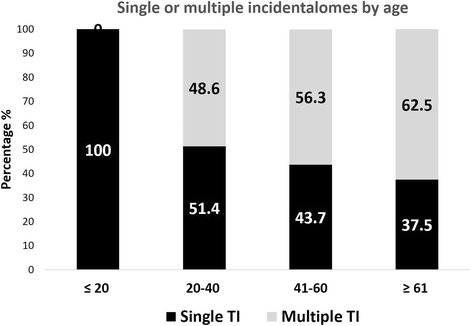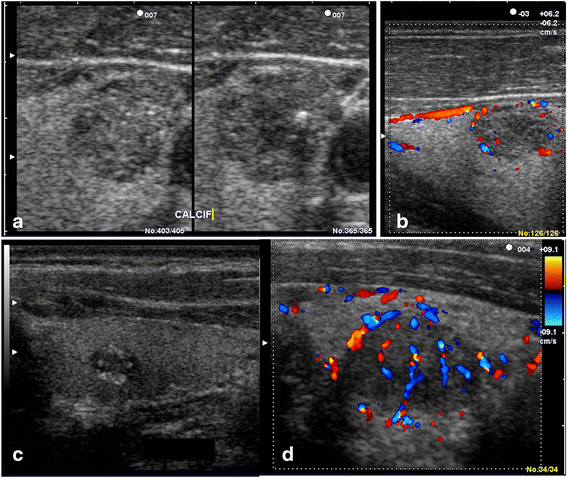Ultrasonographic prevalence and characteristics of non-palpable thyroid incidentalomas in a hospital-based population in a sub-Saharan country
- PMID: 28259145
- PMCID: PMC5336663
- DOI: 10.1186/s12880-017-0194-8
Ultrasonographic prevalence and characteristics of non-palpable thyroid incidentalomas in a hospital-based population in a sub-Saharan country
Abstract
Background: Thyroid incidentalomas (TI) are highly prevalent asymptomatic thyroid nodules with ultrasound as the best imaging modality for their detection and characterization. Although they are mostly benign, potential for malignancy is up to 10-15%. In sub-Saharan Africa little data exists on the prevalence and risk categorization of TI. The aim of this study was to determine the prevalence and ultrasound characteristics of non-palpable thyroid incidentalomas among adults in sub-Saharan setting.
Methods: A cross sectional study was carried out between March and August 2015, at two university teaching hospitals. Sampling was consecutive and included all adults aged ≥ 16 years, presenting for any ultrasound other than for the thyroid, with no history or clinical signs of thyroid disease, and no palpable thyroid lesion. Ultrasound was done using 4 to 11 MHz linear probes. Subjects with diffuse thyroid abnormalities were excluded. Variables studied were age, gender, thyroid volume, ultrasound characteristics of thyroid nodules, TIRADS scores. Differences were considered statistically significant for p-value < 0.05.
Results: The prevalence of TI was 28.3% (126 persons with TI /446 examined). This prevalence was 46.2% in population ≥ 61-year-old; 6.3% in population ≤ 20-year-old; 33.3% for females and 18.4% for males (p < 0.001). Of the 241 TI found, 49.4% were cysts, 33.6% solid, 17.0% mixed; 37.8% <5 mm and 22% >10 mm. Solid TI were mainly hyperechoic (42.0%), 3/81 were markedly hypoechoic. Sixty-nine out of 126 persons with TI (54.8%) had at least two nodules. Solitary nodules were predominant in the age group ≤20 years. Of 241 TI, 129 (53.5%) were classified TIRADS 2, 81 (33.6%) TIRADS 3, 25 (10.4%) TIRADS 4A, 6 (2.5%) TIRADS 4B, and none TIRADS 5. Characteristics associated with increased risk of malignancy where mostly founded on solid nodules (p < 0.000) and nodules larger than 15 mm (p < 0.001).
Conclusion: Thyroid incidentalomas were very frequent with a prevalence of 28.3% and potential risk of malignancy in 12.9%. Prevalence had a tendency to increase with age and in female. Cystic nodules were the most prevalent. Potential for malignancy would be increased for larger and solid nodules.
Keywords: Prevalence; Sub-Saharan country; TIRADS; Thyroid incidentaloma; Thyroid nodule.
Figures




Similar articles
-
Ultrasound prevalence and characteristics of incidental thyroid lesions in Nigerian adults.Afr J Med Med Sci. 2013 Jun;42(2):125-30. Afr J Med Med Sci. 2013. PMID: 24377197
-
TIRADS for sonographic assessment of hypofunctioning and indifferent thyroid nodules.Nuklearmedizin. 2015;54(3):144-50. doi: 10.3413/Nukmed-0712-14-12. Epub 2015 Apr 13. Nuklearmedizin. 2015. PMID: 25865064
-
[The prevalence of incidentaloma--asymptomatic thyroid nodules in the Tricity (Gdansk, Sopot, Gdynia) population].Endokrynol Pol. 2006 May-Jun;57(3):196-200. Endokrynol Pol. 2006. PMID: 16832782 Polish.
-
Thyroid incidentalomas.Horm Res. 2007;68 Suppl 5:199-201. doi: 10.1159/000110625. Epub 2007 Dec 10. Horm Res. 2007. PMID: 18174746 Review.
-
Thyroid incidentalomas: management approaches to nonpalpable nodules discovered incidentally on thyroid imaging.Ann Intern Med. 1997 Feb 1;126(3):226-31. doi: 10.7326/0003-4819-126-3-199702010-00009. Ann Intern Med. 1997. PMID: 9027275 Review.
Cited by
-
Prevalence and characterization of asymptomatic thyroid nodules in Assin North District, Ghana.PLoS One. 2022 Feb 2;17(2):e0263365. doi: 10.1371/journal.pone.0263365. eCollection 2022. PLoS One. 2022. PMID: 35108333 Free PMC article.
-
The Spectrum of Thyroid Nodules at Kinshasa University Hospital, Democratic Republic of Congo: A Cross-Sectional Study.Int J Environ Res Public Health. 2022 Dec 3;19(23):16203. doi: 10.3390/ijerph192316203. Int J Environ Res Public Health. 2022. PMID: 36498276 Free PMC article.
-
Prevalence and Associated Factors of Thyroid Incidentaloma among Adult People Attending Gondar University Hospital, Northwest Ethiopia.Ethiop J Health Sci. 2020 Jan;30(1):23-30. doi: 10.4314/ejhs.v30i1.4. Ethiop J Health Sci. 2020. PMID: 32116429 Free PMC article.
-
The prevalence of thyroid nodules and its factors among Chinese adult women: A cross-sectional study.Front Endocrinol (Lausanne). 2022 Aug 17;13:967380. doi: 10.3389/fendo.2022.967380. eCollection 2022. Front Endocrinol (Lausanne). 2022. PMID: 36060984 Free PMC article.
-
Thyroid nodules in centenarians: prevalence and relationship to lifestyle characteristics and dietary habits.Clin Interv Aging. 2018 Apr 3;13:515-522. doi: 10.2147/CIA.S162425. eCollection 2018. Clin Interv Aging. 2018. PMID: 29662307 Free PMC article.
References
MeSH terms
LinkOut - more resources
Full Text Sources
Other Literature Sources
Medical

